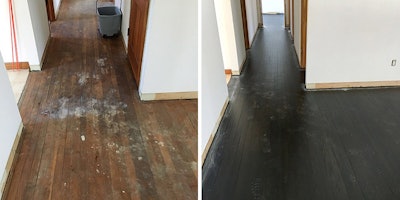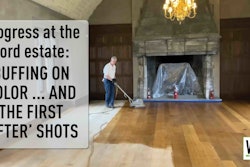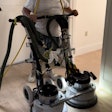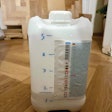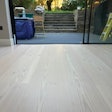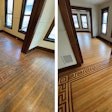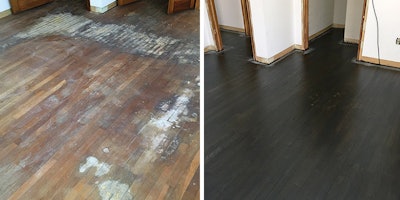
As a wood floor pro, I get the "pet stains on my wood floor" questions all the time. It's mostly about stains from cats and dogs, but I have been asked about pygmy goats and potbelly pigs peeing on the floors, too. The culprits vary: older pets who have become incontinent, puppies and kittens who aren't trained yet, dogs and cats who never did get trained, cats who couldn't hit the litter box even while in it! But wait, there's more: stains from babies, and even "older folks" who have leaked repeatedly on the same spot, causing a permanent stain. No, really. So, let us address the problem: urine.
Deep dive into ... well, pee
What is urine? About 91–96 percent of urine is water. It also contains an assortment of inorganic salts and organic compounds, including proteins, hormones and a wide range of metabolites. The total solids in urine are on average 59 grams per person per day; urea is more than 50 percent of this. All mammals excrete urine, and it is all similar in makeup.
Now that we have those fun facts down, let us look at what this liquid does when it comes in sustained contact with wood fibers. This is the easy part: It stains wood dark as it soaks into the fibers, and it smells bad. (It is a powerful compound. In ancient times urine was used to bleach furs white, to soften and lighten leather products, to bleach teeth for that brighter, whiter smile—yuck!—and some cultures drank it, thinking it had medicinal properties. Okay, I digress.)
Typical urine stain scenarios
Let's look at some typical scenarios.
1. You bought a home knowing that under that carpet there were beautiful oak floors. Removing the carpet reveals dark sticky spots where some critter has used that spot or those spots to relieve himself for years.
2. You are rearranging the furniture and find a spot in the corner where Fido 1, 2 and 3 have been peeing for several decades. They like to find the spot where another animal was and claim it as their own.
3. You are sanding a floor knowing there are some questionable spots and stains, but when you hit it with the big machine the odor forces you to leave the room in search of a full-face respirator and a shower.
Common first fix: hydrogen peroxide
If you go on the internet and search for ways to remove pet stains from wood floors, you will find it is an industry unto itself. There are YouTube videos showing folks spraying hydrogen peroxide on stains for days, soaking towels in hydrogen peroxide and covering that with plastic (note that this is typically the 40 percent hydrogen peroxide intended for beauty salons and taxidermy, not the common drug store one). These remedies work to a degree. The peroxide will bleach the surface stain and, if done over days, may even penetrate beyond the surface cells of the wood, removing deeper staining. In a lot of cases, that's good enough.
When they want a pristine floor...
In other cases, though, that's far from enough. Now you've gone from a dark stain to a bleached-out area. If what you are looking for is a pristine, uniform wood floor, more work needs to be done. It may entail tinting or staining to blend in the areas in question. The problem though, my friends, is deeper than what we can see. The urine has soaked into the floor through the gaps or cracks down to the tongues and grooves and beyond. Sometimes you may sand the floor, stain it and tint it to where it looks 100 percent better. Then you coat it … and there is a chemical reaction with the organic compounds still in the wood or lurking in the cracks and gaps. They are reactivated by the finish you applied, and now you are back to square one. This most often happens with waterborne coatings, but I have seen it in oils and solvents. Where do we go from here?
If the client wants a pristine wood floor, the best option is to remove the stained wood in question and weave in new. I have, over the past five decades, opened floors where the damage was way beyond the flooring itself and had affected the subfloor, and sometimes even the joists. Keep in mind that a "repair" is invisible and a "patch" is what amateurs do, so be a pro and do a proper weave-in of new flooring, repairing the underpinnings as needed. Give your client a floor that will last another 50 years of pets, old folks, goats, pigs and life!
Other options without full replacement
If expectations are such that removing part of the floor isn't necessary, or the stains are more superficial, there are options. Sand off any remaining finish to expose the extent of the stain. This will also expedite the cleaning/bleaching process, as all the wood grain is exposed. It may help to tape off the damaged area to prevent bleaching of the unaffected area. Brush on straight hydrogen peroxide (sometimes called "blond in a bottle") and allow it to dry. Do this multiple times until the stain is gone. Lightly abrade the area and apply stain to match the surrounding areas as close as possible. This works best when sanding the entire floor. After getting the color matched as close as possible, if needed, you can apply thin coats of tinted finish to blend the entire floor and achieve a uniform look. Always clear-coat after applying tinted finish so the color won't "walk off" during use. Simply choosing a dark stain can help disguise stains that won't completely sand out.
Some other options that may work to a degree are: oxalic acid (found in some professional cleaning products), a paste made of water and baking soda that dries and is then sprayed with vinegar, Urine Gone (yes, "As Seen on TV"), Clorox Urine Remover, Pro's Choice USR (urine stain remover), Nature's Miracle Stain Dual Action Stain and Odor Remover ... and so on. I can't speak to some of the commercial products seen on the internet or TV, because I haven't used them. Keep in mind, once again, you may be trading a dark stain for a light stain, and remember to consult with the manufacturer of the finish you are using to make sure they approve of your process. Good luck, and remember to hold your nose.
